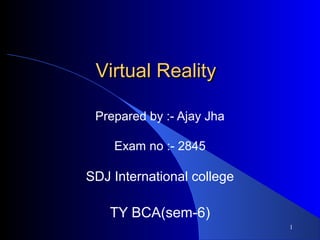
Virtual reality
- 1. 1 Virtual RealityVirtual Reality Prepared by :- Ajay Jha Exam no :- 2845 SDJ International college TY BCA(sem-6)
- 2. 2 OutlineOutline Introduction The history of VR Types of VR Technologies of VR Applications of VR Current problems & Future work Conclusion Reference
- 3. 3 IntroductionIntroduction What is Virtual Reality(VR)? Virtual Reality refers to a high-end user interface that involves real-time simulation and interactions through multiple sensorial channels. .
- 4. 4 IntroductionIntroduction ((CCont’d)ont’d) Why VR? VR is able to immerse you in a computer-generated world of your own making: a room, a city, the interior of human body. With VR, you can explore any uncharted territory of the human imagination.
- 5. 5 Brief HistoryBrief History In 1950s, flight simulators were built by US Air Force to train student pilots. In 1965, a research program for computer graphics called “The Ultimate Display” was laid out. In 1988, commercial development of VR began. In 1991, first commercial entertainment VR system "Virtuality" was released.
- 6. 6 Types of VR SystemTypes of VR System Windows on World(WoW) – Also called Desktop VR. – Using a conventional computer monitor to display the 3D virtual world. Immersive VR – Completely immerse the user's personal viewpoint inside the virtual 3D world. – The user has no visual contact with the physical word. – Often equipped with a Head Mounted Display (HMD).
- 7. 7 Types of VR System(Cont’d)Types of VR System(Cont’d) Telepresence – A variation of visualizing complete computer generated worlds. – Links remote sensors in the real world with the senses of a human operator. The remote sensors might be located on a robot. Useful for performing operations in dangerous environments.
- 8. 8 Types of VR System(Cont’d)Types of VR System(Cont’d) Mixed Reality(Augmented Reality) – The seamless merging of real space and virtual space. – Integrate the computer-generated virtual objects into the physical world which become in a sense an equal part of our natural environment. Distributed VR – A simulated world runs on several computers which are connected over network and the people are able to interact in real time, sharing the same virtual world.
- 9. 9 VR ExamplesVR Examples (Cont’d)(Cont’d) Telepresence VR
- 10. 10 VR ExamplesVR Examples (Cont’d)(Cont’d) Distributed VR
- 11. 11 Technologies of VR--Technologies of VR--HardwareHardware Head-Mounted Display (HMD) − A Helmet or a face mask providing the visual and auditory displays. − Use LCD or CRT to display stereo images. − May include built-in head-tracker and stereo headphones
- 12. 12 Technologies of VR--Technologies of VR--HardwareHardware Binocular Omni-Orientation Monitor (BOOM) − Head-coupled stereoscopic display device. − Uses CRT to provide high-resolution display. − Convenient to use. − Fast and accurate built-in tracking.
- 13. 13 Technologies of VR--Technologies of VR--HardwareHardware Cave Automatic Virtual Environment (CAVE) − Provides the illusion of immersion by projecting stereo images on the walls and floor of a room-sized cube. − A head tracking system continuously adjust the stereo projection to the current position of the leading viewer.
- 14. 14 Technologies of VR--Technologies of VR--HardwareHardware Data Glove – Outfitted with sensors on the fingers as well as an overall position/orientation tracking equipment. – Enables natural interaction with virtual objects by hand gesture recognition.
- 15. 15 Technologies of VR--Technologies of VR--HardwareHardware Control Devices – Control virtual objects in 3 dimensions.
- 16. 16 Technologies of VR--Technologies of VR--SoftwareSoftware Software packages available in market – Multiverse (Freeware) – Virtual Reality Studio ($100) – Sense8 World Tool Kit (WTK) (over $1000) – Autodesk Cyberspace Development kit (over $1000)
- 17. 17 Technologies of VR--Technologies of VR--SoftwareSoftware VRML(Virtual Reality Modeling Language) − Standard language for interactive simulation within the World Wide Web. − Allows to create "virtual worlds" networked via the Internet and hyperlinked with the World Wide Web. − Aspects of virtual world display, interaction and internetworking can be specified using VRML without being dependent on special gear like HMD. – VR models can be viewed by Netscape or IE with a browser plug-in.
- 18. 18 ApplicationsApplications Entertainment – More vivid – Move exciting – More attractive
- 19. 19 ApplicationsApplications (Cont’d)(Cont’d) Medicine − Practice performing surgery. − Perform surgery on a remote patient. − Teach new skills in a safe, controlled environment.
- 20. 20 ApplicationsApplications (Cont’d)(Cont’d) Manufacturing – Easy to modify – Low cost – High efficient
- 21. 21 ApplicationsApplications (Cont’d)(Cont’d) Education & Training – Driving simulators. – Flight simulators. – Ship simulators. – Tank simulators.
- 22. 22 Current problems &Current problems & FutureFuture workwork Cybersickness / simulator sickness Low-fidelity Expensive Lack of integration between application packages High-fidelity system Cost-saving Collaborative High-level contact between participants in distributed VR
- 23. 23 ConclusionConclusion VR offers us a new way to interact with computer. VR enables us to experience the virtual world that is impossible in real world. VR is changing our life, eventually VR will increasingly become a part of our life.
- 24. 24 Comments & Questions?Comments & Questions? Any questions...?